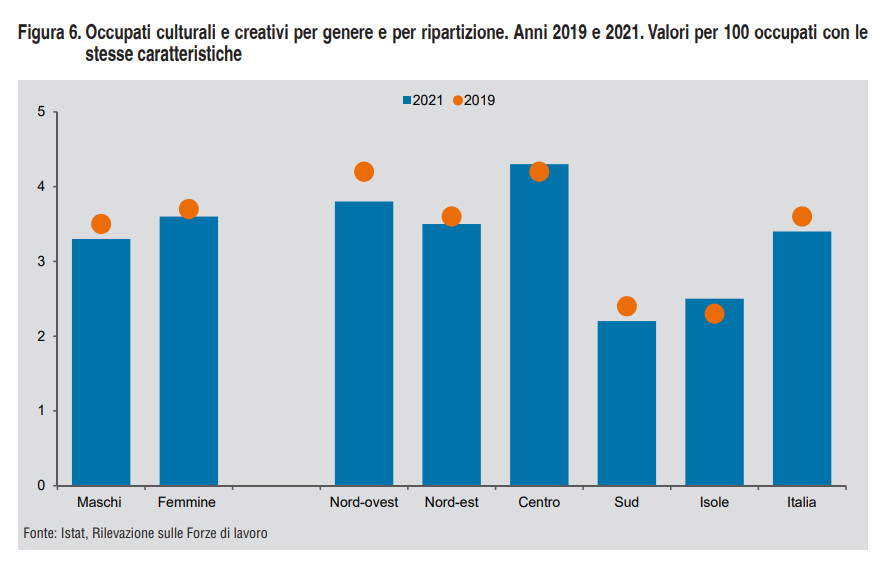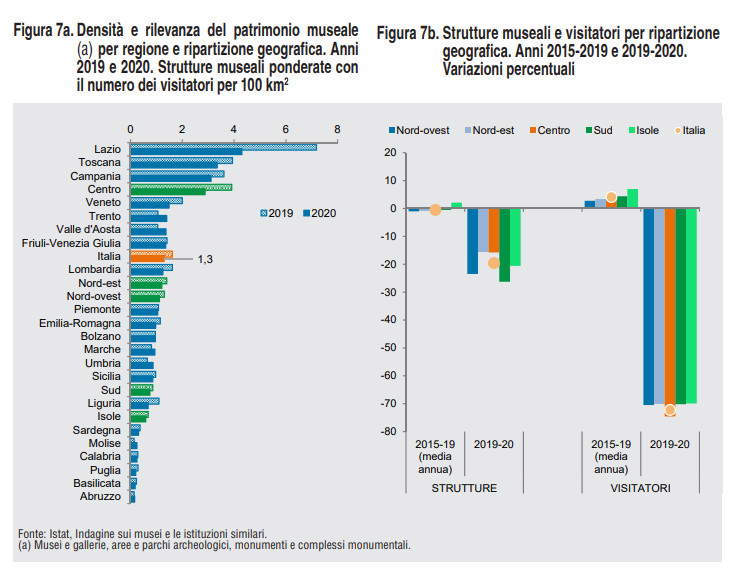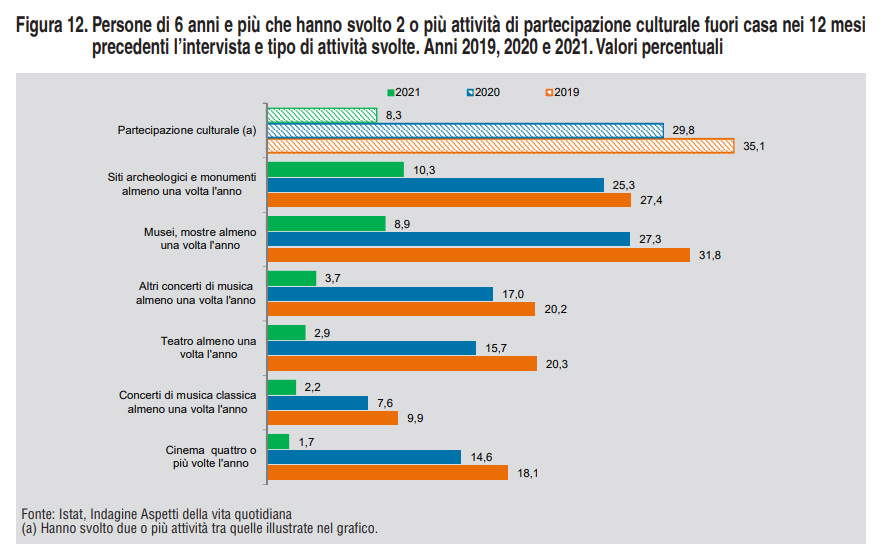The two-year pandemic has hit the world of culture hard in all its declensions, in economic, employment and fruition terms. It is an observation easily deduced by everyone, but now comes, mercilessly, the photograph ofIstat that with the presentation of the ninth report Bes - Benessere equo e sostenibile certifies the wound opened in these last 24 months in all its dimension. The collapse in cultural participation has been accompanied by a consequent loss of jobs quantified at 55,000 in two years.
The numbers were pitted on Thursday, April 21 at a press presentation. The book (242 pages) provides an overview of the 12 “domains” into which well-being is divided (Health; Education and training; Work and life-time balance; Economic well-being; Social relations; Politics and institutions; Security; Subjective well-being; Landscape and cultural heritage; Environment; Innovation, Research and Creativity; Quality of Services) based on 153 indicators, analyzed as they evolved over the two pandemic years, 2020, the year of the health emergency shock, and 2021, the year of economic recovery and employment, examining differences between population groups and between territories.
The COVID-19 pandemic has profoundly changed many aspects of the daily lives of individuals, families, the organization of society and the world of work, bringing about new arrangements and continuous changes that, from time to time, have affected health, education, labor, the environment and services and, as a result, the well-being of individuals. Of note, among the things highlighted in the Report, the percentage of dissatisfied adolescents with low mental health scores has doubled: they were 3.2 percent of the total in 2019, 6.2 percent in 2021. This is about 220,000 teens aged 14 to 19 who say they are dissatisfied with their lives and are, at the same time, in a condition of low psychological well-being. In fact, the psychological well-being condition of 14-19 year olds has worsened in 2021. The score for this age group has dropped to 66.6 out of 100 for girls (down 4.6 points from 2020) and 74.1 for boys (down 2.4 points from 2020). In the pandemic years, it is the 14-19 year olds who are the only ones who have experienced a “significant deterioration in life satisfaction, with the percentage of very satisfied dropping from 56.9 percent in 2019 to 52.3 percent in 2021.”

Let’s go here to analyze what concerns culture starting withemployment, which at the end of the second year of the pandemic crisis calculates 55,000 fewer, with a relative loss of -6.7 percent between 2019 and 2021, more than double the contraction of employment as a whole (-2.4 percent).
With restrictions on cultural venues to counter the pandemic, out-of-home cultural participation in the 12 months prior to the interview drops from 35.1% to 29.8% between 2019 and 2020, and between 2020 and 2021 it plummets to 8.3%. It drops for both men and women, but more steeply for the latter: -22.5 percentage points from 2020 and -20.5 among men. “Women,” ISTAT’s central director Linda Laura Sabbadini had this to comment during the report presentation, “after having been characterized since 2017 by higher levels of cultural participation outside the home than men, in 2021 they realign themselves with males (women 8.1 percent; men 8.5 percent), thus losing their previously acquired advantage.”
Between 2019 and 2020, the most pronounced reductions were in theater attendance and going to a museum or exhibition (which lost about 4.5 percentage points). In 2021, the enjoyment of museums/exhibitions and archaeological sites and monuments, although affecting a higher percentage of people than the other forms of cultural participation considered (8.9 percent and 10.3 percent, respectively), represent the activities that declined the most (-18.4 percentage points the former and -15.4 percentage points the latter).
The distribution of out-of-home cultural participation by age group shows a curve that gradually flattens out between 2020 and 2021 at the younger ages, which, although known to have higher levels of cultural participation, have experienced the greatest reductions in the pandemic years, moving closer and closer to the other age groups.
In 2020 and 2021 the decrease in out-of-home cultural participation was found to be across the country, however, in both years higher levels of participation were confirmed in the North-Central regions than observed for the South.



In 2020, there were 3,924 (-19.6 percent from the previous year) permanent exhibition facilities that were open to the public for at least part of the year (1.3 per 100 square kilometers including museums and galleries, archaeological areas and parks, monuments and monumental complexes); these welcomed more than 36 million visitors (-72.3 percent from the previous year) during the periods not subject to the pandemic containment restrictions.
Our country is historically characterized by a widespread distribution of museum facilities (more than a third located in municipalities of up to 5,000 inhabitants and almost 40% also in areas of difficult access), but also by a high concentration of flows: only 12.0% of facilities are located in metropolitan cities, which nevertheless welcome 43.0% of visitors in 2020, while about 70% are concentrated in pole municipalities, which are more accessible. It is therefore evident how the infrastructure deficit contributes to limiting the full enjoyment of a significant part of the museum heritage. In 2020, the indicator of museum heritage density and relevance shows a less concentrated spatial distribution than in 2019 (Figure 7).
Thus, the impact of the pandemic was severe, although 92.0 percent of facilities provided physical access for visitors for at least part of the year and about 30 percent made available the possibility of enjoying the collections through virtual tours of exhibition spaces.
Of the seven regions that ranked above the average value (1.3 per 100 km2), those traditionally most visited by international tourism (Lazio, Tuscany, Campania and Veneto) recorded the largest losses. In this quite exceptional picture, the northeastern regions (especially the autonomous province of Trento and Friuli-Venezia Giulia) and Valle d’Aosta seem to have held up better, maintaining comparatively high values of the indicator and positive changes compared to the previous year. The recovery of flows expected in the coming years should be accompanied by a redistribution strategy to enhance the value of smaller centers to a greater extent, reducing anthropic pressure on the great “magnets” of international tourism. Some of the facility presentation initiatives already implemented in 2020 go in this direction: museums have activated at least
an online activity for users by making use of internal staff who already had the necessary professional skills (in 85.4 percent of cases), investing in the training of new professional figures (11.7 percent) or acquiring external professional figures (24.3 percent of cases); plan as a priority the recovery and strengthening of the relationship with the public in attendance through integrated tickets, promotions or facilitated access (29.2% of facilities) and plan to invest in the organization of flows and access in security (12.2%)
In 2019, public spending on culture and landscape remains among the lowest in Europe in relation to GDP (0.4 percent against an EU27 average of 0.6 percent). Municipal spending on culture is stable (19.9 euros per capita), with a very wide gap between the North and the South (25.8 euros per capita versus 9.3, respectively).
We can therefore speak of an overall impoverishment of Italian society, and culture is undoubtedly among the sectors most affected by the pandemic crisis. Where we have passed points of no return, by now, such as the inevitable spread of the fruition from home of what is cinema setting negative assumptions to the recovery of Cinema in theaters. This was discussed on Feb. 6 in the Rome Chronicle of the “Corriere della Sera” with an investigation by Flavia Fiorentino reporting the closure of 30 theaters and a collapse in box office “box office collapses by 70 percent, from January 2019” to date due to thematic TVs and streaming viewing sites.
In 2021 while reading at least 4 books a year remained stable compared to 2020 (22.9%), reading newspapers 3 or more times a week decreased (from 24.8% to 23.2%), bringing the overall indicator on reading down (36.6%, was 38.2% in 2020). In 2021, 7.4 percent of people aged 3 and older went to the library at least once in the 12 months prior to the interview, confirming the decline that began in 2020 as a result of the limitations brought about by the pandemic (falling from 15.3 percent in 2019 to 12.2 percent in 2020).
“The overall picture is composite, and is still overshadowed by the pandemic,” explained ISTAT President Gian Carlo Blangiardo, for whom “many gaps have been maintained or even widened,” and among them is that of municipalities’ spending on culture, for which the gap is clearly to the advantage of the Center-North.“ Blangiardo called for an ambition to strategize and invest in young people and to understand that ”policies for the well-being of young people are policies for the well-being of the whole country,“ and that we do not need transitional measures, but to ”rebuild the structural foundations of this well-being."
For young people, the percentage visiting museums goes from 31.8 percent in 2019 to 27.3 in 2020 to 8.9 percent in 2021. For theater it goes from 20.3 percent to 15.7 to 2.9 in 2021. Cultural participation as a whole increases from 35.1 percent in 2019 to 29.8 in 2020 to 8.3 percent in 2021.
The data presented in this report mark perhaps one of the lowest points for culture in republican Italy and certainly calls for a great deal of commitment on the part of those involved in the field for the near future. There is a need to restart and probably also to rethink the cultural offer to be proposed in order to go beyond the usual clichés and be innovative even if we talk about the past. The challenge for the cultural world lies in this having to re-invent itself after the pre-pandemic overtourism hangover and the forced abstinence of the last two years that have changed people in their perception of reality, their habits, and the way they spend their time and resources.
Warning: the translation into English of the original Italian article was created using automatic tools. We undertake to review all articles, but we do not guarantee the total absence of inaccuracies in the translation due to the program. You can find the original by clicking on the ITA button. If you find any mistake,please contact us.